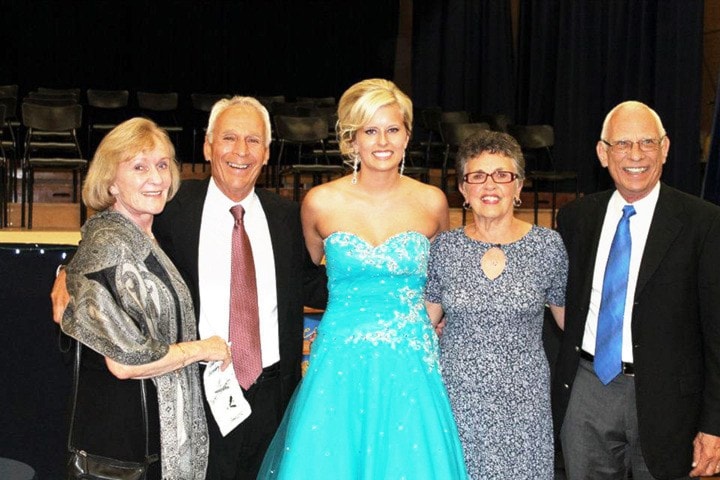A Lake Cowichan Secondary School graduate who became known as the “world famous physician” in 1969 has received a prestigious award from the University of British Columbia (UBC).
Dr. William Carpentier, who grew up in Lake Cowichan and graduated from high school here, received an Alumni Award of Distinction from UBC Nov. 14 in Vancouver.
“[Carpentier] is acknowledged as one of the greatest contributors to the field of space life science,” an announcement from UBC states. “His later career has focused on nuclear medicine, and four decades of exceptional work has resulted in important applications and advancements in radiology, diagnostics and cancer treatment.”
Carpentier, who graduated from UBC medical school in 1961, was nominated for this prestigious award by the Faculty of Medicine Alumni Association.
“It’s a very nice honour,” he said. “As they said at the awards dinner, there’s something like 280,000 UBC alumni — to be singled out as somebody who has done something out of the ordinary is quite an honour.”
Carpentier says his time at UBC and in Lake Cowichan before that helped instill a feeling of wanting to do something with his life.
“Deciding on a career is based on your lifetime experience, and I was very lucky in my life I think — I was raised in a family that encouraged members to think for themselves and plan and make something of themselves,” he said. “I think going through high school in Lake Cowichan, that was emphasized. Then I think at UBC, that atmosphere encouraged you to make something of your life, to do something.”
After medical school, Carpentier went on to become the chief physician for the Apollo 11 crew.
Carpentier’s first interest was around aviation and aerospace medicine because while studying at Victoria College, he developed a passion for flying.
While in medical school, Carpentier discovered that Ohio State University offered a program in aviation medicine, and he was accepted into the program.
His interest in space was also kindled while he was in medical school, as Yuri Gagarin became the first man to fly in space in April 1961, and Alan Shepard was the first American to fly in space May 1961.
Carpentier was selected as one of NASA’s first aeromedical clinical investigators in 1965, responsible for the health and welfare of the astronauts, and he helped develop a sophisticated set of standardized measurements for NASA’s astronauts.
Carpentier served as flight surgeon for several Gemini and Apollo missions, including Apollo 11, the first lunar landing.
“He worked closely with Neil Armstrong, Buzz Aldrin and Michael Collins during their pre- and post-flight training, accompanying them on their 45-day worldwide tour and even standing in for the astronauts when they were unavailable, earning him the nickname ‘world famous physician,’” according to UBC.
Carpentier had become interested in nuclear medicine while working at NASA, and when the Apollo program ended in the 1970s, Carpentier went back to school for a training program in nuclear medicine. He joined the Nuclear Medicine Division at Scott & White Healthcare in Texas in 1973, where, according to UBC, “he was instrumental to the division’s success and expansion, particularly during the significant growth of nuclear cardiology.”
Carpentier retired from Scott & White in 2003, and he still lives in Texas, in a small town on the lake called Belton.
Since retiring, Carpentier has been working with NASA researchers to study changes to the cardiovascular system in microgravity.
“At first, I was looking to write a book on the Gemini program because some of the data got lost,” he said. “That turned into a much bigger project. I am trying to develop a database, especially on the changes to the cardiovascular system in space, starting at the beginning with Al Shepard’s flight in May 1961, and documenting changes flight by flight.”
Carpentier has finished documenting the first two decades of space flight so far.
“I’m having a great time,” he said. “It’s really neat when you can go through your life and keep on learning. There’s never a week that goes on in my life that I don’t learn something new.”
Carpentier considers being involved in Apollo 11 the biggest highlight of his career.
“I was their flight surgeon so I was involved with that crew for the best part of a year, and I think that was incredibly fortunate for me to be able to be involved in that part of history,” he said. “I think when people are looking back and they say ‘what did they do in the 20th century?’, one of the things on the list will be that it was the century man stepped on the moon. It was an important milestone in the history of man, and to be associated with that program and with that crew had to be the highlight.”
Although Carpentier now calls Belton home, he does get back to Lake Cowichan — where his brother Gary and sister-in-law Sharron live with their family — quite often, and he and his wife Willie spend their summers at a cabin they built on Pender Island.
